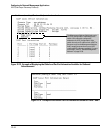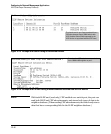
12-45
Configuring for Network Management Applications
LLDP (Link-Layer Discovery Protocol)
Displaying Advertisements Currently in the Neighbors MIB. These
commands display the content of the inbound LLDP advertisements received
from other LLDP devices. These commands can also display the content of
inbound CDP advertisements. (For more on how the switches handle data
received in CDP advertisements, refer to “LLDP and CDP Data Management”
on page 12-51).
Syntax show lldp info remote-device [ port-list ]
Without the [ port-list ] option, this command provides a global
list of the individual devices it has detected by reading LLDP
advertisements (and also CDP advertisements). Discovered
devices are listed by the inbound port on which they were
discovered.
M
ultiple devices listed for a single port indicates either or both
of the following:
– A discovered device is transmitting both LLDP and CDP
packets with different chassis and port ID information.
– Multiple devices are connected to the switch through a hub.
Discovering the same device on multiple ports
indicates that
the remote device may be connected to the switch in one of the
following ways:
– Through different VLANS using separate links. (This
applies to switches that use the same MAC address for all
configured VLANs.)
– Through different links in the same trunk.
– Through different links using the same VLAN. (In this
case, spanning-tree should be invoked to prevent a net-
work topology loop. Note that LLDP packets travel on links
that spanning-tree blocks for other traffic types.)
With the [ port-list ] option, this command provides a listing of
the LLDP data that the switch has detected in advertisements
received on the specified ports. If neighbor data is read from
CDP advertisements, the switch remaps this information into
the switch’s LLDP neighbors MIB in addition to the CDP
Neighbors MIB.
For descriptions of the various types of information displayed
by these commands, refer to Table 12-4 on page 12-29.


















